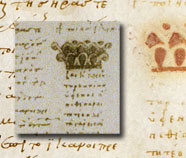Resurrecting the Iliad
Homer's Epic Poem Lives Anew Digitally
Brent Seales says the enormity of what they were about to do hit him as the waterway opened up into the Grand Canal, and the famed Piazzetta San Marco came into view. Seales, a UK computer scientist, was a member of a team of 20 classicists, conservators and photographers from across the globe who stepped off the water taxi that day in May 2007. Their trip, the culmination of five years of negotiations, brought them to the nexus of eastern and western scholarship—the Biblioteca Marciana in Venice, Italy—to realize their goal of offering the Iliad to the world with the click of a mouse.
Since the 15th century the Marciana library has housed the Venetus A—the oldest surviving complete text of Homer’s epic poem that glorifies and laments the death of young men in battle. The Venetus A is from the 10th century A.D., but the Byzantine goat skin parchment includes notes and comments that reach back as far as the 3rd century B.C., to the work of Homeric scholars in Alexandria, Egypt.
The text is beyond priceless.
Only a handful of people had ever seen the actual Venetus A manuscript, and only a slightly larger group had access to the most recent photographs of the precious text. In 1901 Italian scholar Domenico Comparetti sliced each of the Venetus A’s 645 pages off their binding, pressed them between glass, and photographed them with black and white film. But these photographs turned many of the tiny scholarly notes into mere smudges. So Harvard University’s Center for Hellenic Studies (CHS), a Washington D.C.-based group of Greek scholars, led the push to take new high-resolution photos of the manuscript.
Technology Meets Antiquity
Back in Kentucky, Ross Scaife, a UK Greek scholar and longtime collaborator with the CHS, had spent the last 15 years of his career championing open scholarship—freely distributing images and texts in a digital format for the widest possible audience. The images of most ancient texts are restricted on a pay-per-use basis. A pioneer in applying technology to antiquities, Scaife was a founding editor of the Stoa Consortium for Electronic Publication in the Humanities (this umbrella project set the standard for open-access, digital humanities publication) and the Suda On Line, a web database for work on Byzantine Greek semantics.
And it was Scaife who forged the Iliad collaboration, bringing CHS scholars together with the UK computing team of Seales and Matt Field.
Scaife and Seales were co-investigators on EDUCE, a project that uses non-invasive scanning technology to virtually unwrap objects that can’t be physically unwrapped, like the delicate, charred scrolls from the Herculaneum library that were destroyed by the eruption of Mount Vesuvius in 79 A.D. Scaife recognized the potential of applying this technology to the Venetus A. Seales explains, “Our role was to capture the exact 3-D shape of every crinkled page.”
“The 3-D scans were just one more way to preserve the document in its current state,” says Field, who wielded the laser scanner mounted on a robotic arm. Field has a B.S. in computer science from UK and now works full time on the staff of the university’s Center for Visualization and Virtual Environments, which is directed by Seales. “There’s a lot of bend and warp to those pages. In 1901, they cut and physically flattened each page under glass. There’s no way you’d even consider doing that now!”
So a 3-D scanner was just one piece of gear Seales and the CHS team carried from the water taxi to the Marciana library.
Venice in Springtime
May and June were the only months the Marciana library would allow the fragile Venetus A out of the vault (the only climate-controlled section in the 15th-century building), due to the relatively low heat and humidity. But even then the team had to fight the elements (with air conditioning, dehumidifiers and a ventilation system) by constructing a make-shift studio in a small storage room on the library’s second floor. They set up a specially designed metal cradle for the book, lights with shutters that could be closed when the photographer was not shooting, and calibrated the robot-mounted laser. This was a particularly tricky task, Field says, because each time anyone on the second floor took a step, the whole floor vibrated.
Setup took an entire week, but soon the team was in a 100-page-per-day groove. The conservator’s gloved hand would turn the page, the photographer would shoot it with a 39-megapixel digital camera, Field would scan each page by “painting” the page with strips of laser light, and the classicists would review each digital photo for readability.
The team finished imaging the manuscript ahead of schedule, so they were able to shoot close-ups and ultraviolet shots that the scholars hoped would improve the readability of text in certain places, revealing writing that had been smudged out and letters that had worn away. The skin of the parchment absorbed ultraviolet (UV) light, and the ink reflected the light, which helped to differentiate the ink from its background.
Digital Treasure Trove
In the end, the team had 700, 40-megapixel digital photos. Now the burden lay on the shoulders of the UK team. Back in Kentucky at the Center for Visualization and Virtual Environments, grad student Eric Cooker cleaned up the 3-D scans while Field and fellow programmer Ryan Bowman wrote the software to register—precisely overlay—the images.
This software lined up the new color photographs with the UV and close-up shots, as well as the 1901 Comparetti photos. Then the software essentially “pasted” the high-resolution photographs onto the 3-D scan of the page and pressed it against a virtual plane to flatten it—giving even more clarity to the tiny scholarly notes.
Bowman shows two examples of what this process allows you to see: “If you look at the edge here, there’s something that looks like a smudge under normal lighting, but if we switch to ultraviolet, we can see a note. And on this page, here’s the 1901 version with an illustration of a crown. Now the new photo: the crown has almost completely evaporated.”
The just-released web-based version of the Venetus A uses an interface that allows the user to zoom in and zoom out on the manuscript. This kind of interactivity requires a significant amount of bandwidth—a fast rate of data transfer—so the entire collection of images is housed on a server at the CHS and a mirror server at UK.
Chris Blackwell, one of the classicists from the Center for Hellenic Studies who went to Venice, says, “When I look at everything that’s in the Venetus A—the illustrations, the comments in the margins, the comments in the narrow margins, the comments between the lines, the little summaries of each chapter, the conclusions on each chapter—it really makes me think that the scribe who copied it out in the 10th century was trying to make the equivalent of the ‘deluxe DVD version’ of the Iliad. He took every single thing he had at his disposal about the Iliad and put it all together in this one, very compact package made of goat skin and written in ink.”
“The ability to see what’s been disappearing over the past 100 years, and the chance to do an apples-to-apples comparison of every page gives scholars so much more information than just a photograph,” says Seales. “We think it’s fantastic that the actual original images—not just degraded, pixilated copies—are available for any scholar.”
To experience the digital Venetus A, visit http://chs.75.harvard.edu/manuscripts.
Ross Scaife (1960-2008)
“Ross and I found a real partnership that went deep,” Brent Seales says. “He got involved with EDUCE—Enhanced Digital Unwrapping for Conservation and Exploration—because he was a Greek scholar and most of the Herculaneum manuscripts are Greek. He loved the potential of this project to rediscover the wisdom of the ancient world and share it through today’s technology.” (Seales is currently doing test scans on one of these Herculaneum fragments, on loan from the Sorbonne in Paris.)
With the Venetus A project and the impending Herculaneum discoveries, Seales says his colleague was very close to realizing his dreams. “It’s hard to accept that he could get so sick at the point when he was on the cusp of finally achieving things for which he’d been planning and working for years. But Ross made me see that life is less about achieving than it is about becoming.”
Allen Ross Scaife, 47, professor of classics at the University of Kentucky, died of cancer on March 15, 2008, at his home in Lexington, Kentucky.

An illustration of people being devoured by lions springs to life in the new color photographs of the Venetus A, the oldest complete manuscript of Homer’s Iliad.

The Piazzetta San Marco in Venice

UK’s Matt Field scans the text of the Venetus A with a laser scanner mounted on a robotic arm. The painstaking process captures the 3-D shape of the page.

A crown tops a column of text in the 1901 Comparetti photo(inset). The 2007 photo reveals how much of the crown has disappeared.

A smudge in the margin (left) becomes a scholarly note (right) when photographed under UV light.

Ross Scaife (1960-2008)
